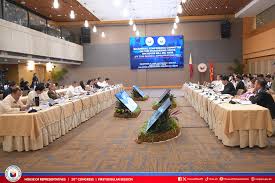While San Miguel Corp. (SMC) may accuse its critics of barking up the wrong tree for hitting its airport project in Taliptip, Bulakan, Bulacan and blaming the diversified conglomerate as part of the entitled few that have “franchises” to reclaimed kingdoms in Manila Bay, the fact remains that Ramon Ang’s SMC is also involved in the 650-hectare Navotas Bay Reclamation Project that has been denounced by fisherfolk.
Those who continue to fish in the coastal areas of Navotas City have slammed the SMC project for killing their livelihood and worsening the flooding in their communities. “The fisherfolk know that the main reason why there is a severe flooding not only in our city but in the whole National Capital Region (NCR) is the reclamation in Manila Bay, like the 650-hectare Navotas Bay Reclamation Project of the SMC and the local government unit (LGU),” the Pambansang Lakas ng Kilusang Mamamalakaya-Navotas (Pamalakaya–Navotas) argued.
The project led to the demolition of mussel farms that affected 1,000 fisherfolk families starting in 2022. “While storms are inevitable, the government has a responsibility to protect the environment, prevent severe damage in times of disaster, and aid the livelihood of the fisherfolk… Instead, they favor projects that benefit only big businesses and foreign investors. Now, fishermen and ordinary citizens bear the consequences,” Pamalakaya–Navotas added.
Manila Bay covers 199,000 hectares, more than twice the size of the 94,900-hectare Laguna de Bay, and stretches from Cavite and Parañaque, Pasay, Manila, Malabon, and Navotas in Metro Manila and many towns in Bulacan, Pampanga and Bataan. which were severely flooded. The bay has become shallow over the years, its depth now averaging just 55 feet, tracking the record of Laguna de Bay, once the refuge of crocodiles and a big number of freshwater fish species. Today, the lake’s average depth is only 2.5 meters, with a volume of 3.2 billion cubic meters and a shoreline that spans approximately 220 kilometers. With that average depth, Laguna de Bay does not pass muster the minimum depth required for water harvesting.
Sad fate unites the two water bodies. Laguna de Bay has become a huge septic tank, with industries disgorging their waste into the waterway, and soil and other detritus from the Sierra Madre mountains upstream are carried from the Marikina River and also find their way into the lake, like those from at least 23 rivers and creeks and literally hundreds of streams in Rizal and Laguna that drain into the lake. Those who think of using Laguna de Bay as a huge cistern for floodwaters that would be pumped out to Manila Bay are kidding us. The only way the lake can perform this function is by dredging it to increase its capacity.
Perhaps it has become irrational to think of transforming the lake into a catch basin for floods that could have been prevented had government been more conscious of its duty as an ecological steward. Despite its size, Laguna de Bay has an average depth of only 2.5 meters, making it relatively shallow to accommodate floodwaters within the kind of volume generated by Typhoons Ondoy and Carina. Pumping out floodwaters to Manila Bay would not help since the waters would only flow back to Metro Manila via the Pasig River and the creeks that litter the metropolis. Ageless Presidential Legal Counsel Juan Ponce Enrile also spoke out against reclamation projects, including the two Pasay City reclamation projects being pursued by Ulticon Builders, Inc. (UBI) of Charlie Gonzalez of Davao City. By blocking natural waterways, the 23 Manila Bay projects covering 47,000 hectares would worsen the backflow and even flood Malacanang Palace.
President Ferdinand Marcos Jr. spoke glowingly of the 5,500 flood control projects completed by the Department of Public Works and Highways (DPWH) at a cost of P255 billion during his July 22, 2024 State of the Nation Address (SONA) but Typhoon Carina hit the metropolis two days later and compelled him to say that the design of those flood control projects must be looked into. He also blamed garbage, garbage everywhere for the floods. The poor people’s alliance Kadamay did not let the comment without a scathing retort. “The flooding and the calamity are not because of the people’s actions. This is due to the state’s pursuit of profit by allowing reclamation projects, mining, and others,” Kadamay shot back.
Of course, floodwaters can be harvested, too, and then pumped into cisterns for irrigation and other purposes. Scientists have estimated that up to 68% of the runoff ends up in the sea, the rest absorbed by the soil to replenish groundwater sources, but if the state can keep a substantial of these rampaging waters, there can be plenty of supply for irrigation. Project NOAH and the Japanese government have already prepared maps of floodplains, catch basins and low-lying areas in the country and Tokyo has also produced flood maps for other Southeast Asian nations. These could be put to good use to build water impounding areas, the way farmers have been doing in Nueva Ecija and Ilocos Norte. But first, let’s just stop all the reclamation projects of plutocrats, prevent further deforestation upstream, and put floodwaters to good use. In the Netherlands, they even have underground impounding facilities for water as the snow thaws. These facilities made the country a leading agricultural exporter.




